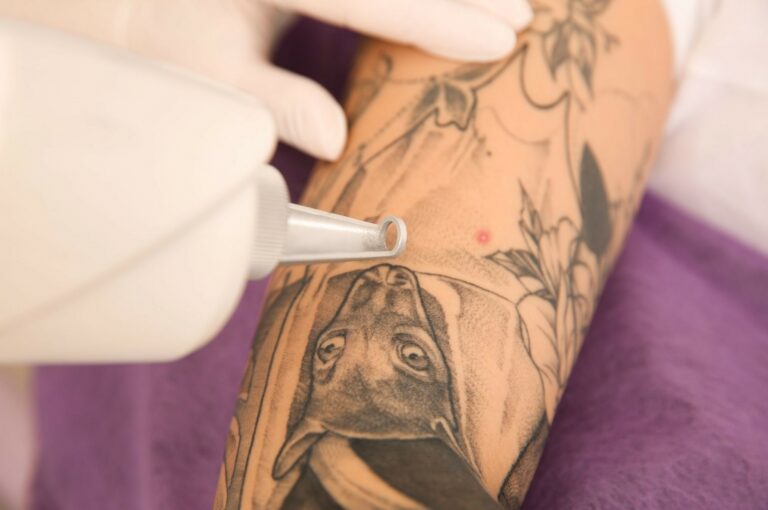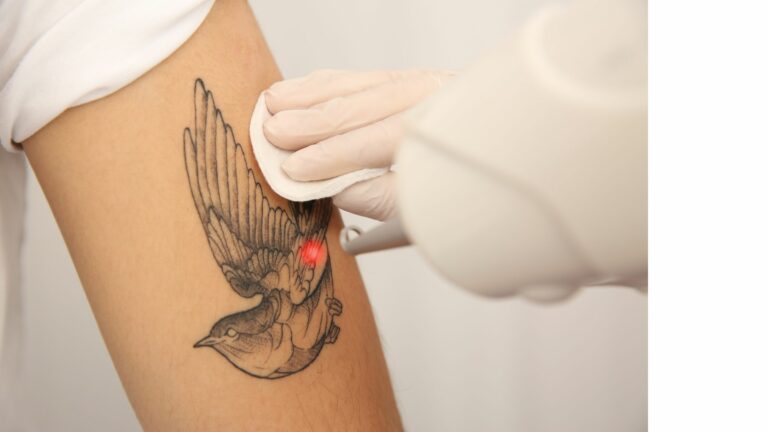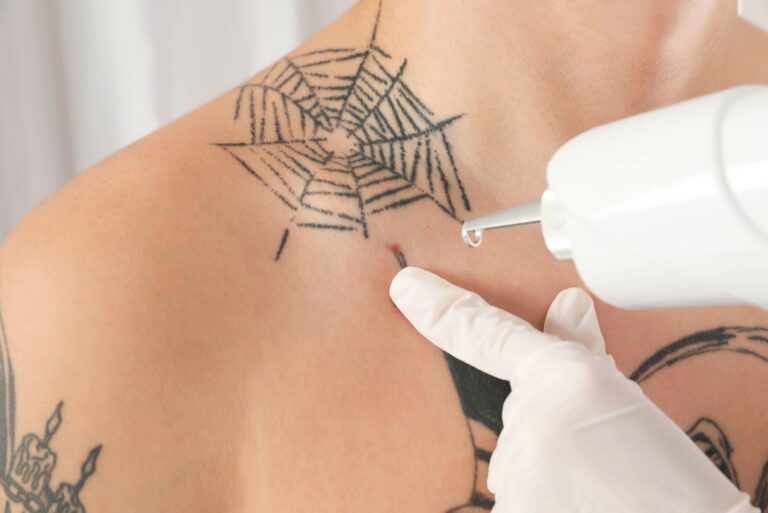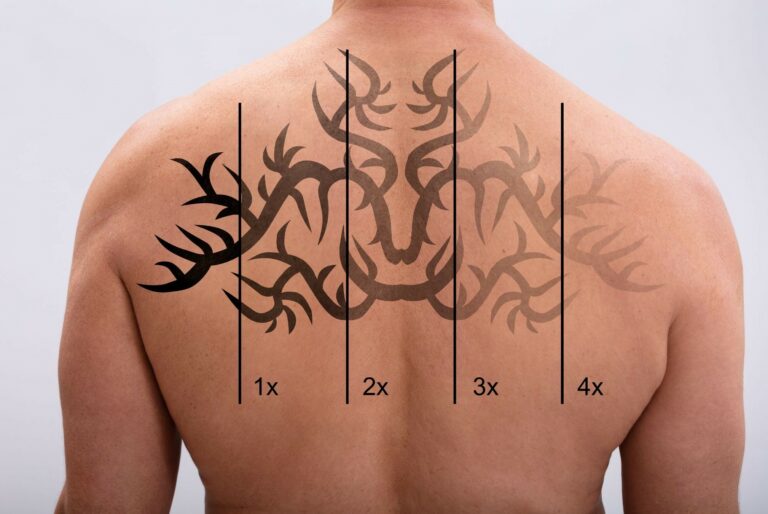Removing Ink: A Comprehensive Guide to Tattoo Removal Methods
The Art of Regret: Comparing Different Tattoo Removal Methods
The Popularity of Tattoos
Tattoos have been a part of human culture for thousands of years, with the earliest evidence dating back to ancient Egypt and Greece. In recent decades, tattoos have experienced a significant increase in popularity, becoming a mainstream form of self-expression and art.
According to a study by the Pew Research Center, nearly 40% of millennials have at least one tattoo, and the industry as a whole is worth over $1 billion. Tattoos can carry deep personal significance or simply serve as aesthetically pleasing body adornment.
However, despite their growing acceptance and popularity, not all individuals are satisfied with their tattoos. Whether due to fading color or design regret, many people seek tattoo removal methods to undo their previous choice.
The Need for Tattoo Removal Methods
While some people are content to live with their tattoos for the rest of their lives, others experience regret over ink that they once loved but no longer do. A survey conducted by the American Society for Dermatologic Surgery found that nearly 25% of people with tattoos regretted getting them. In addition to design regret or fading coloration over time, certain professions may require individuals to remove visible tattoos for employment purposes.
This is especially true in fields such as law enforcement or healthcare where visible tattoos can be seen as unprofessional. As the demand for tattoo removal has increased so has the development of new procedures meant to remove unwanted ink safely and effectively.
A Brief Overview of Different Tattoo Removal Methods
There are several different tattoo removal methods available today; each has its own advantages and disadvantages depending on factors such as budget and skin type. Traditional methods include dermabrasion which involves removing layers of skin until the tattoo is gone which can be painful. Excision involves surgical removal of the tattoo which is also painful and can result in scarring.
Laser tattoo removal is a popular method that involves using high-intensity light to break up the ink particles, which are then absorbed by the body’s immune system. This method may require multiple sessions, but it has a relatively low risk of scarring.
Creams and lotions are also available for those who prefer non-invasive methods. They work by gradually fading the tattoo over time.
Natural remedies such as lemon juice, honey, or aloe vera may also be used but their effectiveness remains largely untested. In this article, we’ll take an in-depth look at each method’s pros and cons to help you determine which option is best for you if you’re considering having your tattoo removed.
Traditional Tattoo Removal Methods
Tattoos have been a popular means of self-expression for centuries, but not everyone who gets inked wants to keep their tattoos forever. Traditional tattoo removal methods include dermabrasion and excision. While these methods may have been the only options in the past, they have their drawbacks.
Explanation of Dermabrasion Method
Dermabrasion is a procedure where the outer layer of skin is sanded off with a rotary abrasive instrument. The process removes the tattoo ink along with the skin layer, causing bleeding and discomfort in some cases. It requires local anesthesia, and its effectiveness depends on factors such as the depth and size of the tattoo, individual healing ability, and aftercare.
The procedure typically takes several sessions spaced 6-8 weeks apart; full healing can take up to several months depending on several factors mentioned earlier. While dermatologists or plastic surgeons are likely to perform this method, it can also be done by trained aestheticians or beauty therapists.
Explanation of Excision Method
The excision method involves removing the tattoo by cutting out the affected area and sewing back together the surrounding skin parts to close up the space left by the removed tissue. This method is particularly effective for small tattoos but may not be practical for large designs due to scarring concerns.
Results vary depending on how well your body heals post-surgery (scarring improves over time), with follow-up treatments available if necessary. Local anesthesia is required during this process as well, which can cause discomfort after surgery.
Pros and Cons of Traditional Tattoo Removal Methods
There are pros and cons associated with traditional tattoo removal methods like dermabrasion and excision:
Pros:
- Easily accessible since many medical practitioners offer these services.
- Effective for smaller tattoos and on specific skin types
- Excision method can be quicker than laser tattoo removal
Cons:
- Costs can add up if multiple sessions are necessary, making it more expensive than some other methods of tattoo removal.
- Dermabrasion can cause discomfort and scarring in some patients
- Excision method may require a longer healing period, thus requiring downtime off work, which could be inconvenient to some clients.
Traditional tattoo removal methods like dermabrasion and excision are still popular today. Although they may not be as comfortable or efficient as the newer laser technology available, they have their place in the cosmetic industry and can provide effective results under certain conditions.
They are especially suitable for people with small tattoos or those with specific skin types that may not respond well to other treatments. However, it is essential to weigh up the pros and cons before making an informed decision about which method is right for you.
Laser Tattoo Removal Method
Laser tattoo removal is one of the most common and effective methods for removing tattoos. It works by using high-intensity light beams to break down the ink particles into smaller pieces, which are then naturally removed by the body’s immune system. The process can take several sessions, depending on the size and color of the tattoo.
Explanation of how laser tattoo removal works
Laser tattoo removal involves a series of treatments in which a laser is used to break down the ink particles in your skin. During each session, the laser will produce bursts of light that target specific colors within your tattoo. The light energy is absorbed by the ink particles in your skin and causes them to heat up and shatter into tiny fragments.
Over time, these fragments are flushed out of your system through natural processes such as sweating and urination. Each treatment session will target a different layer of ink until all of it has been broken down enough to be eliminated from your body.
Advantages and disadvantages of laser tattoo removal
One major advantage of laser tattoo removal is that it is a relatively safe and non-invasive method for removing tattoos. Unlike other methods like dermabrasion or excision, there is no cutting or scraping involved in laser treatments. Another benefit is that it can be used on almost any part of the body without causing excessive scarring or damage to surrounding tissue.
However, there are also some potential downsides to laser tattoo removal. One major disadvantage is that it can be quite expensive compared to other methods like creams or lotions.
Additionally, because lasers use intense heat energy during treatment sessions, there may be some pain or discomfort involved during each session. Some patients may also experience mild swelling or redness after treatments as well.
Comparison between traditional and laser tattoo removal methods
When comparing traditional methods like dermabrasion or excision to laser tattoo removal, there are a few key differences to consider. One major difference is that laser treatments tend to be less painful and more effective at removing tattoos than other methods. Additionally, because lasers can target specific colors within a tattoo, they are often able to remove tattoos with a higher degree of precision than other methods that involve cutting or scraping the skin.
On the other hand, traditional methods may be more suitable for patients who have certain types of tattoos or skin conditions that make them less suitable for laser treatments. Ultimately, the decision between different tattoo removal methods will depend on your individual needs and preferences.
Creams and Lotions for Tattoo Removal
Introduction
In recent years, creams and lotions have become one of the most popular methods for removing tattoos. These products are marketed as a less painful and more affordable alternative to laser or dermabrasion methods. In this section, we will explore how creams and lotions work in removing tattoos and the pros and cons of using them for tattoo removal.
How Creams and Lotions Work in Removing Tattoos
Creams and lotions used for tattoo removal contain various ingredients that aim to break down the ink pigments in the skin. These ingredients usually include acids such as alpha hydroxy acid (AHA) or glycolic acid, which exfoliate the skin’s top layer to reveal fresh skin underneath.
Some also contain natural ingredients like aloe vera or honey, which have anti-inflammatory properties that may help reduce swelling around the tattooed area. To use these products, you simply apply them directly onto your tattooed skin, following the instructions on their packaging.
Most require multiple applications over several weeks or months before you see any significant results. The process can take longer than other methods since creams and lotions work gradually to remove tattoo ink.
Pros of Using Creams and Lotions for Tattoo Removal
One of the biggest advantages of using creams and lotions for tattoo removal is that they are generally less painful than other methods like laser or dermabrasion. This is because they do not penetrate as deeply into your skin as these other methods do.
Additionally, many people find these products to be more affordable than laser treatment – with some brands retailing at prices under $50 per container. Another advantage is that you can use them from home without needing professional help which saves on cost if compared to other treatments where professional assistance is necessary
Cons of Using Creams and Lotions for Tattoo Removal
Unfortunately, the effectiveness of creams and lotions for tattoo removal is often called into question. While some people may see significant fading of their tattoos over time, others report little to no change in the appearance of their tattoo. This may be because these products only work on the top layer of skin, rather than penetrating deep enough to reach all layers where ink has been deposited.
Additionally, using these products requires patience as they can take a long time to produce visible results — sometimes months or even a year before noticeable changes occur. However, for people who are determined to avoid more invasive methods or who cannot afford laser removal procedures, creams and lotions offer a gentler alternative.
Conclusion
Creams and lotions are an increasingly popular option for those seeking to remove tattoos but want a less invasive method than laser or dermabrasion procedures. However, it is essential to remember that they might not be effective on all types of tattoos and can take much longer than other treatments. If you decide to use creams and lotions for tattoo removal, make sure you purchase them from reputable sources and follow instructions carefully.
The Power of Nature: Natural Remedies for Tattoo Removal
Tattoos are a form of self-expression and art, but sometimes what we once thought was beautiful can become unwanted or even a burden. That’s when tattoo removal methods come into play.
While traditional methods like dermabrasion and excision can be effective, they often come with high costs and pain levels. This is where natural remedies such as lemon juice, aloe vera, salt, honey and others come in as alternatives to consider.
Explanation on natural remedies such as lemon juice, aloe vera, salt, honey etc.
Natural remedies involve using ingredients that are easily found around the house or at local stores. Lemon juice is an acidic ingredient that has been used for centuries to lighten skin and hair.
It works by lightening the pigmentation of the skin which can help fade tattoos over time when consistently applied on the area. Aloe vera is another popular remedy known for its soothing properties on the skin.
It contains aloin which can help remove dead skin cells and promote new cell growth leading to fading of tattoos over time. Salt is another common ingredient used in natural tattoo removal methods due to its abrasive nature which helps break down ink particles within the layers of skin.
When combined with water or lemon juice to make a paste, it forms an exfoliating scrub that can be gently massaged onto the tattooed area for maximum results. Honey on its own does not have any direct effect on tattoo removal but has been known to moisturize and hydrate areas around tattoos which aids in their overall appearance over time.
Natural remedies efficiency
The general consensus regarding the efficiency of natural remedies in tattoo removal is that they are often limited in their effectiveness. While some natural remedies may claim to fade tattoos, there is a lack of scientific evidence to support their efficacy. The ink particles in tattoos are deeply embedded in the skin, and natural remedies typically do not have the ability to penetrate deep enough to break down the pigments effectively.
Natural remedies such as lemon juice, salt scrubs, and aloe vera are commonly suggested as potential tattoo-fading agents. However, their impact on tattoo removal is generally considered to be minimal, and any fading that may occur is usually attributed to the body’s natural healing processes over time, rather than the specific action of the natural remedy.
It is important to note that individual experiences and outcomes may vary when using natural remedies for tattoo removal. Consulting with a professional tattoo removal specialist or dermatologist is advisable for a more accurate assessment of the available treatment options and their potential efficacy.
Pros and cons of using natural remedies for tattoo removal
Using natural remedies opens up an affordable alternative in removing tattoos compared to laser treatments or surgical procedures that may be beyond someone’s budget range. Additionally, unlike chemical-based creams or other products advertised as “natural,” remedies like lemon juice and aloe vera are completely natural, cost-effective, and chemical-free.
One of the main disadvantages of using natural remedies is that they often take longer to show results compared to laser treatments or surgical procedures. Natural remedies require consistent application over a longer period, sometimes months or even years before the tattoo fades entirely.
Another downside is that their effectiveness depends largely on factors such as the size of the tattoo, ink color, age of the tattoo and skin type. Another disadvantage of natural remedies for tattoo removal is that they can be messy and time-consuming to apply.
Salt scrubs can be abrasive and cause skin irritation if not used correctly. Lemon juice may cause skin sensitivity if applied too frequently or left on for an extended period.
Natural remedies offer an alternative solution for those who wish to remove their tattoos without turning to traditional methods such as excision or dermabrasion or costly laser treatments. They are affordable and generally safe since they involve natural ingredients.
However, it’s important to keep in mind that patience is required when using these methods since they take time to show results, especially for larger tattoos with multicolored inks. Always consult with a dermatologist before trying any at-home remedy for tattoo removal as some people may have allergic reactions from certain ingredients found in these natural substances.
Key takeaways
Tattoo removal has come a long way since the early, invasive methods such as dermabrasion and excision. Laser tattoo removal has become the gold standard in tattoo removal due to its effectiveness and relatively low-risk profile when performed by a trained professional. While creams and lotions for tattoo removal are available, they have not been proven to be as effective as lasers or other traditional methods.
It’s important to note that each person’s experience with tattoo removal will vary based on their own unique circumstances such as skin color, age of the tattoo, size of the tattoo, and location on the body. Some methods may be more effective than others for specific individuals.
When considering which method to use for your own tattoo removal journey, it’s important to weigh factors such as cost, time commitment, pain level, and desired outcome. Laser tattoo removal may require multiple sessions over several months and can be costly but is often considered the most effective option.
Overall recommendations for readers who are considering getting their tattoos removed include doing thorough research on different methods of removal and consulting with a professional before making any decisions. While removing a regrettable or unwanted tattoo can be an emotional process, it’s important to prioritize safety and effectiveness over convenience or cost.
Remember that even if you choose not to remove your tattoos completely or opt for a cover-up instead, there is no shame in changing your mind about your body art. As society becomes more accepting of tattoos in general, it’s becoming increasingly common for people to make changes or modifications to their existing ink – whether it’s removing it altogether or simply altering its appearance in some way.
References
Iatrogenic Deep Dermal Wound Due to Chemical Do-It-Yourself Tattoo Removal – PMC (nih.gov)
Tattoo Removal: Options and Results | FDA
Alexandrite Laser Treatment Explained — DermNet (dermnetnz.org)
Lasers in tattoo and pigmentation control: role of the PicoSure(®) laser system – PubMed (nih.gov)
Medical Disclaimer:
The information provided on this website regarding tattoo removal techniques is for general informational purposes only. It is not intended to be a substitute for professional medical advice, diagnosis, or treatment. Always seek the advice of a qualified healthcare professional regarding any medical condition or concerns, including tattoo removal.
The content presented on this website should not be interpreted as endorsing or promoting any specific tattoo removal technique, product, or service. The effectiveness, safety, and suitability of tattoo removal methods can vary depending on individual circumstances and factors. Therefore, it is crucial to consult with a medical professional or qualified specialist before making any decisions or embarking on any tattoo removal procedure.
The website does not guarantee the accuracy, completeness, or reliability of the information provided. Reliance on any information from this website is solely at your own risk. The website and its owners, authors, and contributors shall not be held liable for any damages or consequences arising from the use of the information provided.
It is important to note that medical practices and standards may change over time, and the information provided on this website may not always reflect the most up-to-date research or guidelines. Therefore, it is recommended to consult with healthcare professionals or reputable sources for the latest information and advice on tattoo removal techniques.
If you experience any adverse reactions, complications, or concerns during or after a tattoo removal procedure, promptly seek medical attention. Only a qualified healthcare professional can assess your specific situation and provide appropriate advice and treatment.
By using this website, you acknowledge and agree to the above disclaimer, and you understand that the website and its owners, authors, and contributors cannot be held responsible for any decisions or actions taken based on the information provided.







